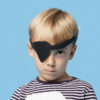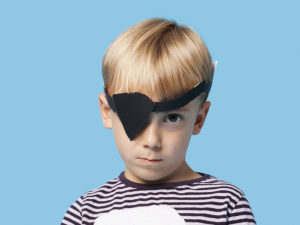
Can Dark Therapy Rebuild Vision?
Can you believe that sitting in a dark room for several days could improve your vision? It seems a little crazy, but some researchers in Canada and at Carnegie Mellon have found that it may just work! In complete darkness, your eyes will be resting much more and allow some unique things to happen. That’s why it’s so important to get enough sleep to support your visual health.
The research in these studies was focused on the eye disorder amblyopia, also commonly referred to as having a lazy eye. It affects nearly four percent of children. Having a lazy eye results in visual stimulation either failing to deliver the visual message to the brain or transmitting a poor message. It usually only affects one eye and occurs in early childhood. Because of the difficulties caused by the lazy eye, the child has poor or blurry vision. This condition can eventually lead to permanent vision loss.
Dark Therapy Study
Researchers from Carnegie Mellon used mice to conduct this study. At the beginning of the study, the research team presented mice with visual stimuli and recorded their neural responses. They then exposed the mice to darkness for eight days. They then presented the mice with the same visual stimuli and again recorded their responses. The mice demonstrated some vision issues the first few days after darkness exposure, but quickly recovered, demonstrating that darkness can speed up the recovery time of injured eyes and therefore eyes with amblyopia.
Dr. Stephen Chase, one of the co-authors of the paper, said that the “data helps shed light on the various, complex factors that drive plasticity in the visual cortex, and bring us one step closer to understanding how eye injury and disease might affect visual perception.”
The Findings
The immersion into total darkness seemed to reset the visual brain and enable remarkable recovery. The researchers believe that a treatment to restore vision by turning out the lights may be in the cards in the future. Even though the whole idea seems very simplistic, they were pleased with the results of the study.
However, the cure was not immediate for the mice. It did take a few days for them to fully recover.
The 2019 study conducted in Canada found similar results when they tested dark therapy on kittens. But the researchers didn’t stop there. They induced amblyopia in kittens but then waited between five and eight weeks to expose the kittens to the dark therapy. They wanted to see if there was a difference in the treatment success of older kittens. And, the researchers were amazed at the results of this second component of the study.
They found some truly astonishing results: “When you put those animals in the dark for 10 days, when they come out, they recover – that is, their deprived (lazy) eye recovers to normal acuity levels within a week. The curious result here is that firstly, when the animal’s older, the darkness doesn’t reduce the visual acuity of the non-deprived eye as it did in the younger animals, which is very good because you don’t want to compromise the vision of (that) eye. The second, probably more astonishing, result is the acuity of the amblyopic eye completely recovered within one week.”
It looks like darkness therapy could have real promise for treating humans with lazy eyes, based on these results!
Therapy as Treatment
Dark therapy is not a new idea; it has been used as a therapy for other disorders. It’s used to treat migraines, dyssomnia, chronic fatigue syndrome, asthma, depression, and fibromyalgia. Dark therapy usually involves a treatment in which all light is eliminated between six and 16 hours per day.
Other Treatment Options for Amblyopia
One of the most common ways to treat amblyopia is with an eye patch. The theory behind this treatment is to cover up the healthy eye and force the “lazy” eye to work harder and become stronger. Some children hate the patch and refuse to wear it. So, another treatment that uses the same theory distorts the vision in the healthy eye through eye drops. This way a child cannot just remove the patch; they have no control over the vision created in the healthy eye after the drops have been inserted.
Another treatment that some receive is vision correction through either surgery or corrective lenses. Both have their risks and are not guaranteed to fix the problem. Natural treatments would seem to be a better first choice for most people.
Natural Vision Therapy
 One of the ways to treat any poor vision problem is by addressing the weakness of the eyes. There are eye exercise programs that can help build your vision to 100 percent naturally. Another natural alternative for eye treatment is through proper vitamins and minerals for healthy vision. Try an eye vitamin supplement like our Ocu-Plus Formula.
One of the ways to treat any poor vision problem is by addressing the weakness of the eyes. There are eye exercise programs that can help build your vision to 100 percent naturally. Another natural alternative for eye treatment is through proper vitamins and minerals for healthy vision. Try an eye vitamin supplement like our Ocu-Plus Formula.
Dark Therapy
It seems the researchers at Dalhousie University in Canada are on the right track with dark therapy as a natural eye treatment. More research will have to be conducted of course, and an acceptable form of the therapy will have to be created for humans. Since the cats were left in complete darkness for 10 days, this is not a realistic expectation for human children.
Experts warn that certain steps must be taken in the care of the eyes. They say that the first step is to find the underlying cause of the amblyopia so a treatment can be decided on. They also warn parents that not enough research has been done to determine what the process will be for treating patients, so parents should not attempt dark therapy on their own.
Until more research is done, fall back on natural treatment methods. Ensure your child eats a nutritious diet full of the vitamins and minerals that are crucial for vision health. Teach them how to do different eye exercises. You may want to create a routine of doing these exercises after each meal. Encourage them to play outside instead of being glued to a screen all day. One day, dark therapy in some form may be the solution to childhood vision problems.
Our Rebuild Your Vision Ocu-Plus Formula Contains All 17 Vitamins, Minerals, and Herbal Supplements to Improve Your Eye Health!












I’m willing to give the trial a crack for medical research I’m 28 male with mild amblyopia only.
I am a woman 97 years of age. I have glaucoma in my lazy eye. The eye grows lazier and i seem to feel if I close my stronger eye, the lazy eye becomes stronger. Is there an exercise I can do or a vitamin to take to help my condition? My pressure is around 15 in both eyes. I have also had cataract surgery in both eyes.
I am in good physical condition. Drive–live alone-exercise, etc.
What is your advice? Betsy Phillips
Our highly visual, predictable, discrete culture has given priority to one of our senses at the expense of the others. This coupled with the development of modern computing technology, has caused a dependence on smartphones, tablets, laptops and desktop computers.
It was expected people started having eye problems. Amazing how dark theraphy can help treat some of these vision impairments, among other benefits.
As a related development, right now some psychiatrists are using light theraphy for treating depression. It seems we are moving away from pharmaceutical solutions to health problems towards more natural ones.